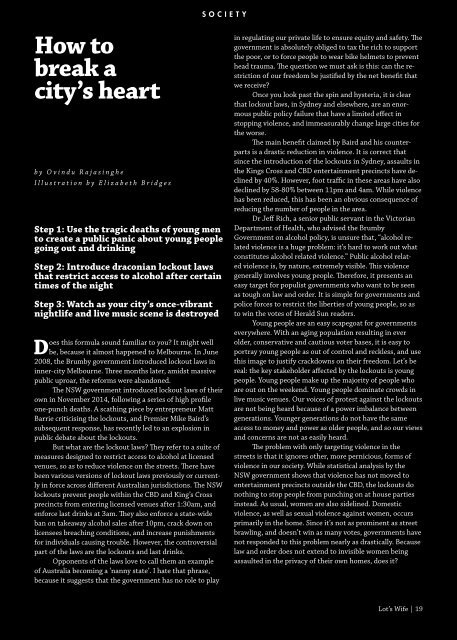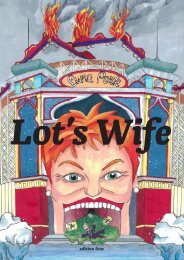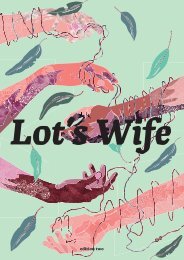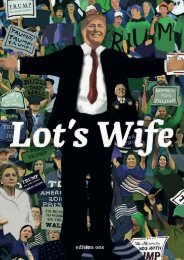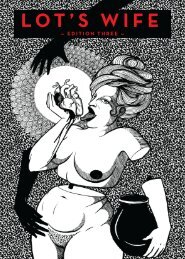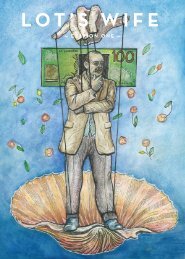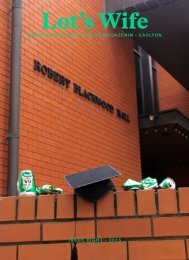Lot's Wife Edition 2 2016
Create successful ePaper yourself
Turn your PDF publications into a flip-book with our unique Google optimized e-Paper software.
SOCIETY<br />
How to<br />
break a<br />
city’s heart<br />
by Ovindu Rajasinghe<br />
Illustration by Elizabeth Bridges<br />
Step 1: Use the tragic deaths of young men<br />
to create a public panic about young people<br />
going out and drinking<br />
Step 2: Introduce draconian lockout laws<br />
that restrict access to alcohol after certain<br />
times of the night<br />
Step 3: Watch as your city’s once-vibrant<br />
nightlife and live music scene is destroyed<br />
Does this formula sound familiar to you? It might well<br />
be, because it almost happened to Melbourne. In June<br />
2008, the Brumby government introduced lockout laws in<br />
inner-city Melbourne. Three months later, amidst massive<br />
public uproar, the reforms were abandoned.<br />
The NSW government introduced lockout laws of their<br />
own in November 2014, following a series of high profile<br />
one-punch deaths. A scathing piece by entrepreneur Matt<br />
Barrie criticising the lockouts, and Premier Mike Baird’s<br />
subsequent response, has recently led to an explosion in<br />
public debate about the lockouts.<br />
But what are the lockout laws? They refer to a suite of<br />
measures designed to restrict access to alcohol at licensed<br />
venues, so as to reduce violence on the streets. There have<br />
been various versions of lockout laws previously or currently<br />
in force across different Australian jurisdictions. The NSW<br />
lockouts prevent people within the CBD and King’s Cross<br />
precincts from entering licensed venues after 1:30am, and<br />
enforce last drinks at 3am. They also enforce a state-wide<br />
ban on takeaway alcohol sales after 10pm, crack down on<br />
licensees breaching conditions, and increase punishments<br />
for individuals causing trouble. However, the controversial<br />
part of the laws are the lockouts and last drinks.<br />
Opponents of the laws love to call them an example<br />
of Australia becoming a ‘nanny state’. I hate that phrase,<br />
because it suggests that the government has no role to play<br />
in regulating our private life to ensure equity and safety. The<br />
government is absolutely obliged to tax the rich to support<br />
the poor, or to force people to wear bike helmets to prevent<br />
head trauma. The question we must ask is this: can the restriction<br />
of our freedom be justified by the net benefit that<br />
we receive?<br />
Once you look past the spin and hysteria, it is clear<br />
that lockout laws, in Sydney and elsewhere, are an enormous<br />
public policy failure that have a limited effect in<br />
stopping violence, and immeasurably change large cities for<br />
the worse.<br />
The main benefit claimed by Baird and his counterparts<br />
is a drastic reduction in violence. It is correct that<br />
since the introduction of the lockouts in Sydney, assaults in<br />
the Kings Cross and CBD entertainment precincts have declined<br />
by 40%. However, foot traffic in these areas have also<br />
declined by 58-80% between 11pm and 4am. While violence<br />
has been reduced, this has been an obvious consequence of<br />
reducing the number of people in the area.<br />
Dr Jeff Rich, a senior public servant in the Victorian<br />
Department of Health, who advised the Brumby<br />
Government on alcohol policy, is unsure that, “alcohol related<br />
violence is a huge problem: it’s hard to work out what<br />
constitutes alcohol related violence.” Public alcohol related<br />
violence is, by nature, extremely visible. This violence<br />
generally involves young people. Therefore, it presents an<br />
easy target for populist governments who want to be seen<br />
as tough on law and order. It is simple for governments and<br />
police forces to restrict the liberties of young people, so as<br />
to win the votes of Herald Sun readers.<br />
Young people are an easy scapegoat for governments<br />
everywhere. With an aging population resulting in ever<br />
older, conservative and cautious voter bases, it is easy to<br />
portray young people as out of control and reckless, and use<br />
this image to justify crackdowns on their freedom. Let’s be<br />
real: the key stakeholder affected by the lockouts is young<br />
people. Young people make up the majority of people who<br />
are out on the weekend. Young people dominate crowds in<br />
live music venues. Our voices of protest against the lockouts<br />
are not being heard because of a power imbalance between<br />
generations. Younger generations do not have the same<br />
access to money and power as older people, and so our views<br />
and concerns are not as easily heard.<br />
The problem with only targeting violence in the<br />
streets is that it ignores other, more pernicious, forms of<br />
violence in our society. While statistical analysis by the<br />
NSW government shows that violence has not moved to<br />
entertainment precincts outside the CBD, the lockouts do<br />
nothing to stop people from punching on at house parties<br />
instead. As usual, women are also sidelined. Domestic<br />
violence, as well as sexual violence against women, occurs<br />
primarily in the home. Since it’s not as prominent as street<br />
brawling, and doesn’t win as many votes, governments have<br />
not responded to this problem nearly as drastically. Because<br />
law and order does not extend to invisible women being<br />
assaulted in the privacy of their own homes, does it?<br />
Lot’s <strong>Wife</strong> | 19


